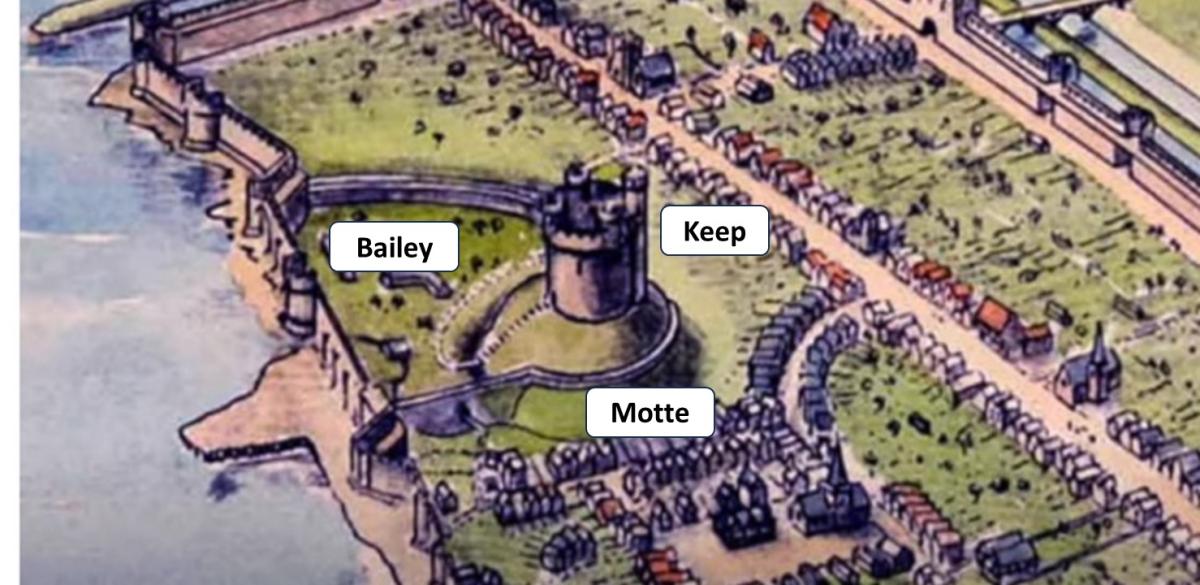Many stone structures from Southampton’s medieval town still remain - walls, vaults and buildings. But regretfully the Castle has vanished – or has it? You can still explore some parts of it, aided by the street names Castle Way, Castle Square and Castle Lane.
Southampton Castle was located in the north-west corner of the town, overlooking the River Test.
Originally wood, by the late 12th century it had been largely converted to stone and played an important part in the wine trade.
By the end of the 13th century, the Castle was in decline, but an attack in 1338, and the threat of French raids in the 1370s led Richard II to undertake extensive rebuilding. The result was a powerfully-defended castle, one of the first in England to be equipped with cannon.
The Castle was built after the standard Norman “Motte and Bailey” model. This involved a large mound of earth - the Motte – and an area around the mound - the Bailey - protected by a Bailey Wall.
Inside the Bailey Wall were the stables, kitchens, storerooms, and the living quarters of the nobles, soldiers and servants.
The Motte was a look-out spot, and the Keep on top, although used mainly as a prison, would serve as the last stronghold in the event of the Castle being attacked. In Southampton, the Motte and the Keep were where Castle House now stands.
The Keep has completely disappeared. It started being deconstructed in the 1500s, as Henry VIII built forts further out along Southampton Water and the Solent, to prevent enemy ships from reaching the city. But it is remembered and echoed by Castle House; some believe the Castle was as tall as this – certainly it was a very dominant feature.

The Motte - the Mound - was considerably lowered in about 1818, but has not quite disappeared. It’s known as Lansdowne Hill, named after an Earl who built a “folly” castle on the ruins of the medieval one in 1805, which was demolished in 1818.
The Bailey Wall ran from the buttress by Forest View, to the Castle East Gate on Castle Lane, and the base is still there - it’s the arches in Castle Way car park.

The Castle’s East Gate linked the Castle to the northern part of the Town. It was demolished in the late 18th century, and the remains were concealed behind later buildings, until they were uncovered by WWII bombing. You can see the bases of the Gate Towers in Castle Way, at the entrance to Castle Lane.
The West Wall of the Bailey was integrated into the Town’s old west walls. It runs from the Castle Garderobe Tower at the southern end, to the buttress by Forest View at the north end. The south part includes three important elements of the Castle.
Castle Hall, where the main “working” buildings of Castle were found, can be viewed from above from a metal gantry, and information panels provide the story of the site.
The Garderobe Tower at the southern end of Castle Hall was the site of the toilets – a two-storey block, with four seats on each floor, probably communal.
At the base is a carefully crafted channel, which used to have a sluice exit at the western end. When the tide was high the water would enter the channel, and then as the tide went out, everything went out with it - a primitive flushing toilet.

The Castle Watergate can be seen in the wall – it provided direct private access to the Castle from the water. And the door to the Castle Vault can also be seen – it was the largest wine vault in the city, and belonged to the King. You can go inside as part of guided tours that run throughout the year, or during special events, such as the Heritage Open Days.
So, with some effort, and help from information boards and plaques, one can still experience the echoes of Southampton’s magnificent Medieval Castle.

Jack Wilson is a tour guide with SeeSouthampton.co.uk














Comments: Our rules
We want our comments to be a lively and valuable part of our community - a place where readers can debate and engage with the most important local issues. The ability to comment on our stories is a privilege, not a right, however, and that privilege may be withdrawn if it is abused or misused.
Please report any comments that break our rules.
Read the rules hereLast Updated: 1st January 1970 12:00 am
Report this comment Cancel